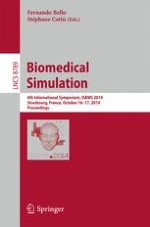This book constitutes the thoroughly refereed conference proceedings of the 6th International Symposium on Biomedical Simulation (ISBMS) which was held in Strasbourg, France, in October 2014. Biomedical modeling and simulation are at the center stage of worldwide efforts to understand and replicate the behavior and function of the human organism. Large scale initiatives such as the Physiome Project, Virtual Physiological Human and Blue Brain Project aim to develop advanced computational models that will facilitate the understanding of the integrative function of cells, organs, and organisms, with the ultimate goal of delivering truly personalized medicine. At the same time, progress in modeling, numerical techniques and haptics has enabled more complex and interactive simulations. The 27 revised full papers (including 16 regular and 11 short papers) were carefully selected from 45 submissions and cover topics such as training systems and haptics, physics-based registration, vascular modeling and simulation, image and simulation, modeling, surgical planning, analysis, characterization and validation.
